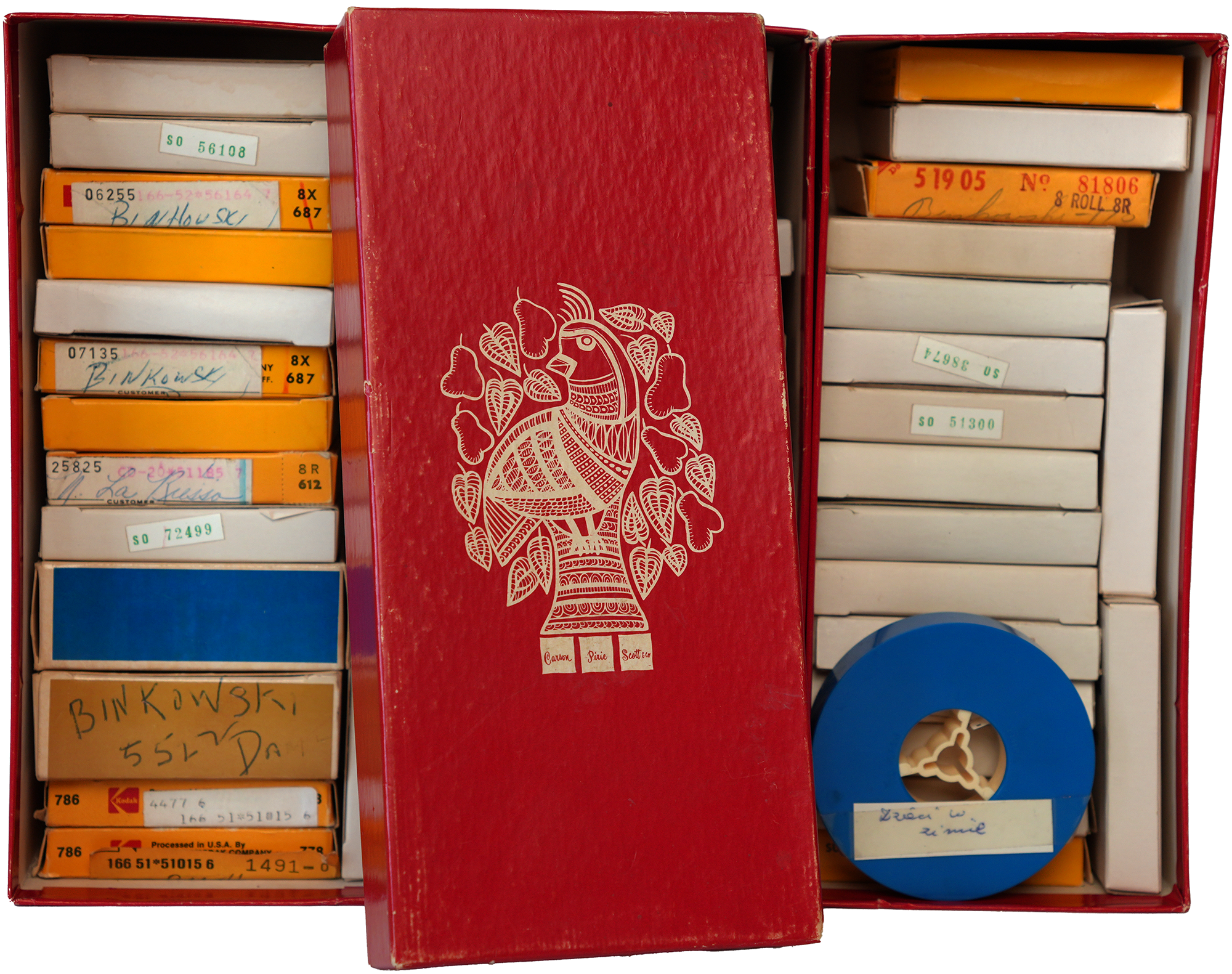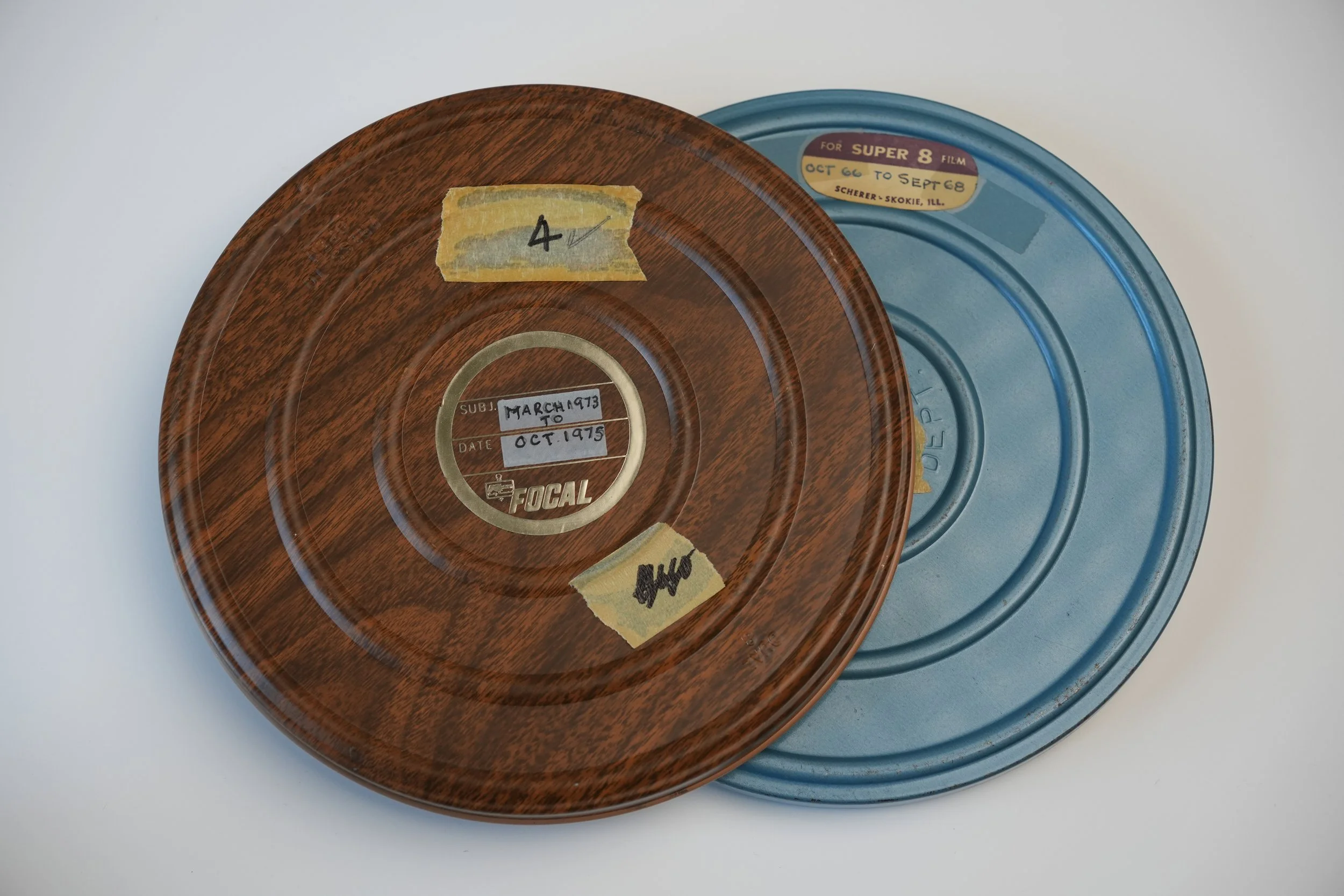Polish Chicago Home Movie and Oral Histories
Victoria Agatha Wielgus Sendra (middle), Bowling Team, 1950s. Courtesy Mary Sendra Anselmo. Image subject to copyright laws.
CONSERVATION & CAPTURE
Grant year: 2024 & 2025
Grant category: Al Larvick National Grant
Grant recipient: Agata Zborowska
Project title: Polish Chicago Home Movies and Oral Histories
Primary makers: Jeanine Marie Binkowski; Maria Bronny-Cieśla; Victoria Agatha Wielgus Sendra; Lucyna Jarosz; Teresa & Wiesław Jaskiewicz; Jerzy "George" Skwarek; Bob Smith & Mary Zuber-Smith
Original format: Super 8 & 16mm film, 8mm Video, in color, black & white, silent, sound
Circa: 1940-2000
Grant support: Cleaning and repair and digital capture of a portion or the entirety of each film and videotape-based collection
Digital capture format: Archival, mezzanine and access level files
Lab: Pro8mm and the Media Burn Archive
Status: 2024 project completed. 2025 in-progress
Online Access: Coming soon
Creative Commons License: Attribution-NonCommercial-ShareAlike 4.0 International: http://creativecommons.org/licenses/by/4.0/
GRANTEE
Agata Zborowska, 2024. Courtesy Adam Ploszaj. Image subject to copyright laws.
Agata Zborowska is a cultural historian with a strong background in visual culture and cultural studies. She completed her PhD at the University of Warsaw in the material culture of post-WWII Poland and has been an assistant professor there since 2022. She is currently a Marie Skłodowska-Curie Global Fellow at the University of Chicago and Katholieke Universiteit Leuven. Her project “Critical Archives of Ordinariness: Vernacular Moving Image Practices and Migrant Identity in Polish Chicago” (short version: “Not-So-Ordinary”) investigates home movies and related oral histories of Polish Chicago before the digital era to challenge and broaden our understanding of evolving migrant and diaspora identities. The project juxtaposes home movies – “ordinary” motion pictures created for family and close friends – with interviews with their creators to uncover this material’s “not-so-ordinary” capabilities for studying minority groups.
Shoe boxes filled with Super8 films, Binkowski Film Collection. Courtesy Adam Ploszaj. Image subject to copyright laws.
COLLECTION & FILMMAKERS
Film still: Jerzy “George” Skwarek, Chicago 1972. Courtesy Chicago Film Archives. Image subject to copyright laws.
The home movie collection of seven Polish and Polish American families in Chicago is selected from material collected within the project "Critical Archives of Ordinariness: Vernacular Moving Image Practices and Migrant Identity in Polish Chicago." The project aims to create the first collection of home movies shot by the members of the Polish diaspora and related oral histories about migration experiences and daily life in Chicago recorded on the movie camera. This approach will allow to analyze not only the movies' content and aesthetics but also the practices related to their creation, viewing, sharing, and their role in the lives of individuals, families, and communities. The project focuses on Chicago, the so-called American Warsaw (from the capital of Poland) – the largest hub of the Polish diaspora in the US and a significant center of Polish culture. For more information about the project please visit:
Film still: Jeanine Marie Binkowski from Binkowski Film Collection, 1970s. Courtesy of Micheline Jaminski. Image subject to copyright laws.
1. Binkowski Film Collection. Jeanine Marie Binkowski (née Kowalska), born in 1931 in Compiègne, France, migrated to Chicago with her parents as a child. Fluent in Polish and French, she worked as a translator at the Circuit Court of Cook County. She also ran a dry cleaning and tailoring business in Chicago's Back of the Yards neighborhood. Her husband, Mieczysław, was born in 1926 in Chicago but was taken by his father to Poland in 1930. He spent World War II in Europe and returned to the United States as a teenager. Together with her husband, Jeanine was active in Polish community organizations. They were involved in heritage clubs, co-organizing meetings, joint trips, and pilgrimages for their members, which she documented on her Super8 camera. The recorded films were sometimes projected at club meetings. In addition to films documenting their social life, she also recorded home movies that showed the family's everyday life, celebrations, and holidays.
The collection consists of 85x50ft reels and 7x400ft reels recorded on Regular8mm and Super8.
Richard Ciesla and Mary Bronny-Ciesla, 1970s. Courtesy Mary Bronny-Ciesla. Image subject to copyright laws.
2. Ciesla/Bronny Family Film Collection. Maria Bronny-Cieśla came to the US with her parents as an infant on the first shipment of Polish immigrants under the Displaced Persons Act (DP Act) passed by the US Congress in 1948. She was president of the Polish Museum of America (2005-2015) and the Legion of Young Polish Women (1988-1990) in Chicago, two of the oldest Polish institutions in the United States. She was awarded the Gloria Artis Medal and the Commander’s Cross of the Order of Merit of the Republic of Poland for her contributions to Polish culture. Richard Ciesla (1940-2025) was born in Chicago to a Polish-American family. He worked as an electrical engineer at Commonwealth Edison and later as the Water and Electric Engineer in Winnetka. Over the years, he served as officer, then President of the Chicago Society of the Polish National Alliance, was President of the Chicago Society Foundation (dedicated to the Polish American community). In his spare time, he played Polish-style polka music on his concertina (the common secular music of Chicago’s European ethnic communities). In the early 1960s, he received a Standard 8mm Bell & Howell movie camera as a gift, which was then stolen. Around 1965, he purchased a Super8 Kodak movie camera, which he used to document the life of his growing family.
The collection consists of 21x50ft, 2x200ft, 2x300ft, and 7x400ft reels recorded on Regular8mm and Super8.
Kodak film boxes. Victoria Agatha Wielgus Sendra Archive collection detail. Courtesy Agata Zborowska. Image subject to copyright.
3. Victoria Agatha Wielgus Sendra was born in Chicago to the first generation of a Polish family that immigrated to the US in the early 20th century. She jointly ran a grocery store with her mother. As a Christmas present from her husband, she received a 16 mm camera and hasn't parted with it since. Victoria Agatha Wielgus Sendra intensely recorded the daily life of her Polish-American family in the mid-20th century. The films intermingle Polish traditions and rituals represented and upheld by her mother and the American culture in which Victoria Sendra and her children were raised.
The collection consists of 95x100ft and 26x400ft reels of 16mm shot in the 1940s-60s. Footage includes the daily life of the first generation of Polish-Americans born in Chicago, including birthdays, weddings, Polish rituals, and family vacations. The collection is archived in Chicago Film Archives.
Film canisters of “Family Album 1965-1968” and “1970-1973”. Courtesy Teresa and Wiesław Jaśkiewicz. Image subject to copyright laws.
4. Wiesław and Teresa Jaskiewicz met in Chicago in 1965 and married after two months of knowing each other. Wiesław came to the United States via England after World War II. Teresa initially arrives for three months in 1965 and stays in the US after their marriage. In the 2010s, they returned to Poland and settled in Teresa's home village (Zakrzew near Radom), where they built an "American-style" house. Their daughter Katarzyna stayed in the US and kept the home movie collection. Teresa and Wiesław Jaskiewicz's family movies were shot in and around Chicago and documented the daily life of a Polish family against the backdrop of American culture.
The collection consists of over a thousand feet of Super 8mm footage shot by Wiesław Jaskiewicz between the 1960s and 70s shot of his daughter's early years, vacations, family celebrations, and gatherings with friends.
Lucyna Jarosz with her son Alex, Chicago, mid-1990s. Courtesy Lucyna Jarosz. Image subject to copyright laws.
5. Lucyna Jarosz came to the US as a tourist in the early 1980s to visit her sister in Chicago. Martial law introduced in Poland on December 13, 1981, unexpectedly prevented her from returning to Poland. After an extended stay, she decided to stay in the US permanently. Lucyna Jarosz bought her first Sony video camera in the mid-1990s after the birth of her second child and began filming her family's daily life. She recorded family celebrations, church ceremonies, New Year's Eve, holidays, and gatherings with friends, where the camera ended up unexpectedly in the hands of the children.
The collection consists of about 25xHi8mm tapes, 120 and 150 minutes long shot between the 1990s and 2000s.
Jerzy “George” Skwarek, Tatry Mountains, Western Carpathians, 1950s. Courtesy Jerzy “George” Skwarek. Image subject to copyright.
6. Jerzy “George” Skwarek immigrated to the US in 1971. He worked as a photojournalist for Dziennik Związkowy, the biggest and oldest Polish-language newspaper in the US, and made amateur travelogues of his trips around the US. After arriving in the United States, fascinated by the metropole, he recorded his first film, “Chicago 1972,” which can be called Symphony of the City. Although the film has magnetic sound, the sound was recorded only at the beginning, where Skwarek introduces the basic facts about the city to the Polish viewer in his native language. Notable among his other films is the recording of a 1981 trip to Texas with one of Poland’s most famous actresses and singer, Kalina Jedrusik. In the movie, she wears a t-shirt with a “Solidarity” print (the logo of a Polish trade union, a broad anti-authoritarian social movement in Poland). A large part of Jerzy “George” Skwarek’s film collection is taken up by films shot at the Ponderosa Sun Club and Naked City in Roselawn, Indiana.
The collection consists of about 55x400ft and 1x600ft reels of Super 8mm and 1x100ft of 16mm shot in the 1970s-80s. Skwarek documented his experience of migration to the US, travels in the US organized for friends and tourists of the Polish American community, and nudist competitions at the Ponderosa Sun Club. The collection is archived in Chicago Film Archives.
Film canisters of “Oct 66 to Sep 68” and “March 73 to Oct 75.” Courtesy Bob Smith and Mary Zuber-Smith. Image subject to copyright laws.
7. Bob Smith and Mary Zuber-Smith Film Collection. Marysia Smith (née Zuber) was born in 1943 in Germany. Then, the family moved to Belgium, and finally came to the US in 1951, growing up in a Polish family that wanted to assimilate into American culture while still cultivating Polish traditions. She worked in the beauty shop, and after college, she worked as a bookkeeper in JCPenney department stores in Chicago. In 1965, she met her husband, Bob, an American native of Chicago, who had already acquired a Super8 camera. She often took the camera with her when going on trips with her girlfriends and during family vacations. The family film collection, which includes weddings, vacations, and trips outside the city, as well as leisure time spent with family and friends, is organized chronologically, not thematically. Each reel is described in detail, including the time period (month, year) in which the film was shot.
The collection consists of about 30x400ft reels recorded on Super8.
Bob Smith and Mary Zuber-Smith, 1968. Courtesy Bob Smith and Mary Zuber-Smith. Image subject to copyright laws.












